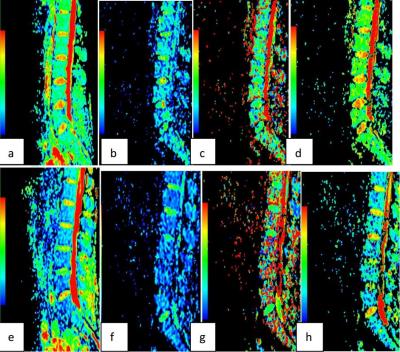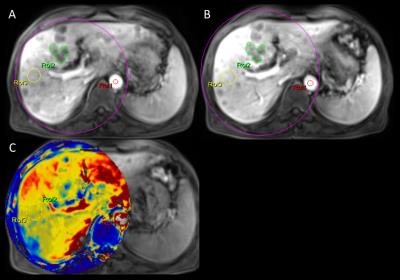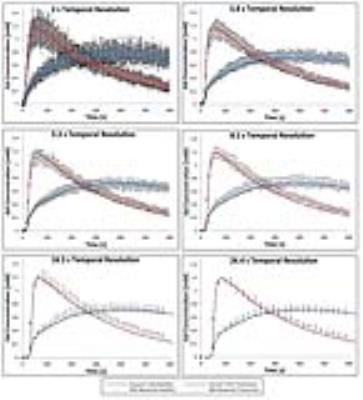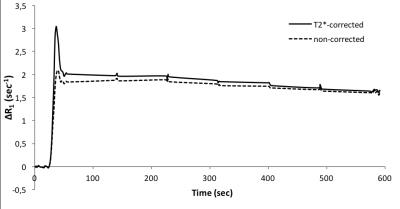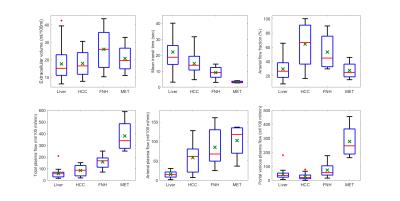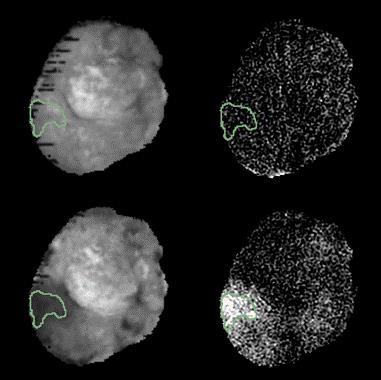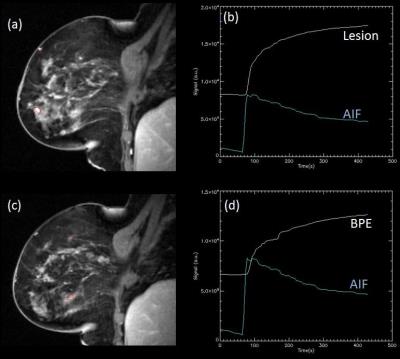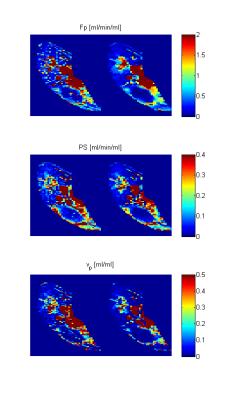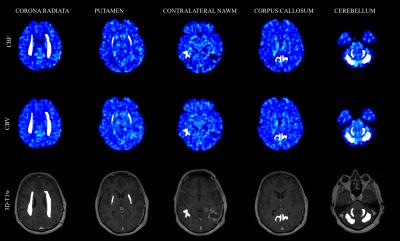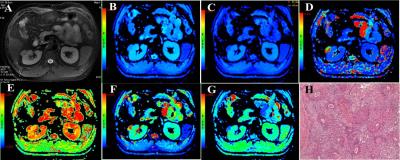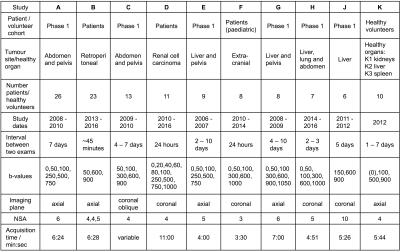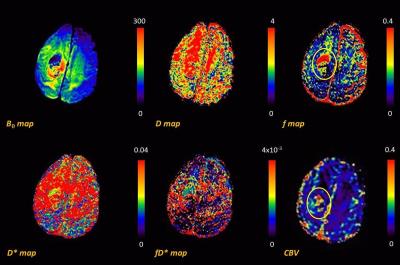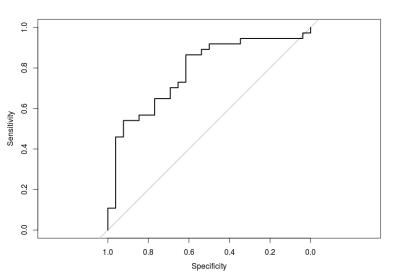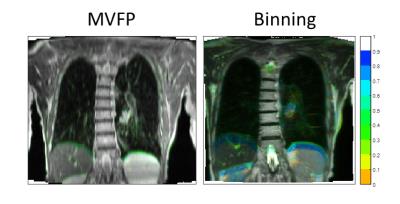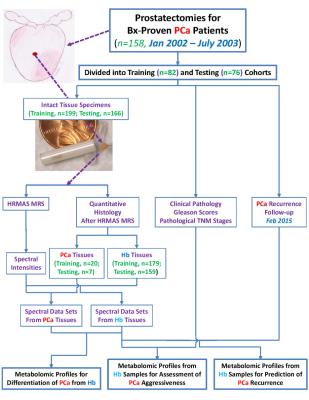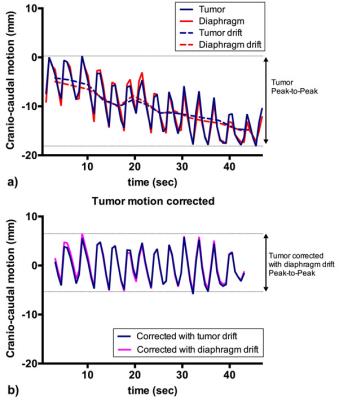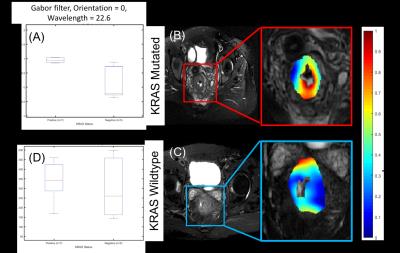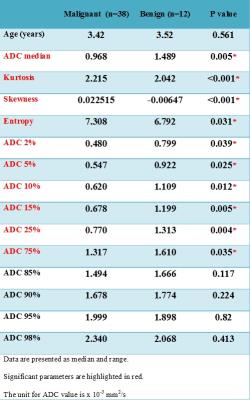Cancer Treatment Response & Preclinical
Traditional Poster
General Cancer Imaging
Thursday, 27 April 2017
| Exhibition Hall |
13:00 - 15:00 |
|
2911.
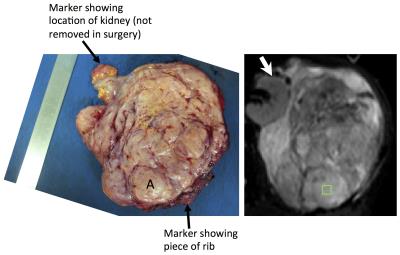 |
ADC and D from diffusion-weighted MRI correlate with histopathological assessment of nuclear-to-stromal ratio, and histology confirms Dixon fat fraction in retroperitoneal sarcomas
Jessica Winfield, Khin Thway, Aisha Miah, Dirk Strauss, David Collins, Martin Leach, Nandita deSouza, Sharon Giles, Christina Messiou
Soft-tissue sarcomas are often highly heterogeneous tumours. Clinical trials of non-surgical treatments, for example combined radiotherapy and systemic agents, require non-invasive methods for response assessment. Quantitative MRI provides non-invasive response assessment of the whole tumour volume, but metrics require validation against histopathology. In this study, 26 patients with retroperitoneal sarcoma were imaged prior to surgery, with written consent, as part of a prospective single-centre study. Diffusion-weighted MRI parameters (ADC, and D from IVIM) showed correlation with nuclear-to-stromal ratio, and were also related to stroma type and stroma grade. Dixon-derived fat fraction correlated strongly with histopathological assessment of fat fraction.
|
|
2912.
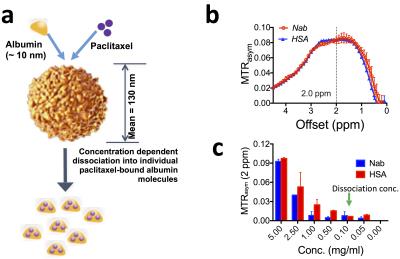 |
Label-free CEST MRI detection of albumin and albumin-based nanoparticles
Yuguo Li, Dexiang Liu, Jiadi Xu, Peter van Zijl, Shibin Zhou, Guanshu Liu
Albumin is emerging as one of the most attractive drug carriers for the targeted delivery of therapeutic peptides and drugs. Herein, we developed a label-free MRI approach for monitoring albumin-based drug delivery systems by directly utilizing the inherent CEST signal of albumin. Our in vitro study showed that both human serum albumin (HSA) and albumin-based nanoparticle Nab-paclitaxel (Abraxane) could generate a strong CEST signal at ~2 ppm. Using this inherent CEST signal, we successfully demonstrated the label-free CEST MRI detection of the tumor uptake and distribution HSA and Nab-paclitaxel in a xenograft mouse model.
|
|
2913. 
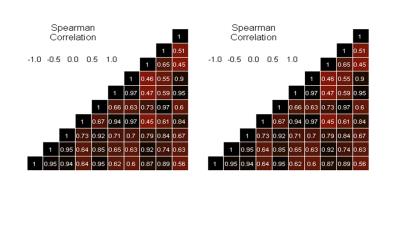 |
Quantitative ADC as an early imaging biomarker of response to chemoradiation in esophageal cancer
Benjamin Musall, Jingfei Ma, Brett Carter, Penny Fang, Amy Moreno, Jong Bum Son, Brian Hobbs, Bryan Fellman, Steven Lin
The goal of the study was to investigate if quantitative ADC can be used as an early imaging biomarker for predicting the treatment response to chemoradiation in esophageal cancer. Using pathological findings as the gold standard, our study demonstrated that the change in quantitative ADC from baseline (before treatment) to interim (two weeks after the initiation of treatment) was highly predictive of whether patients had residual tumors at the end of their treatment.
|
|
2914.
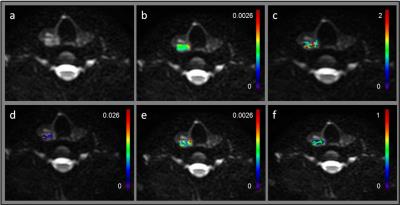 |
Non-gaussian IVIM imaging biomarkers can non-invasively predict the aggressiveness of small papillary thyroid cancers
David Aramburu Nuńez, Yonggang Lu, Vaios Hatzoglou, Andre L Moreira, Hilda E Stambuk, Ramesh Paudyal, Yousef Mazaheri, Mithat Gonen, Joseph O Deasy, Ronald A Ghossein, Ashok R Shaha, Michael Tuttle, Amita Shukla-Dave
There is a need for non-invasive imaging to identify patients with aggressive tumors in papillary thyroid carcinoma (PTC). This study evaluates whether non-gaussian intravoxel incoherent motion (NG-IVIM) DW-MRI has the potential to stratify tumor aggressiveness in PTC. Twenty-four PTC patients underwent pretreatment NG-IVIM DW-MRI at 3T. The apparent diffusion coefficient (ADC), perfusion factor (f), diffusion (D), pseudo diffusion (D*) and diffusion Kurtosis (K) coefficients were calculated from the NG-IVIM model. All patients underwent surgery. Tumor aggressiveness was defined at pathology. ADC and D may be used to distinguish tumors with and without aggressive features in tumor size between 1-2 cm.
|
|
2915.
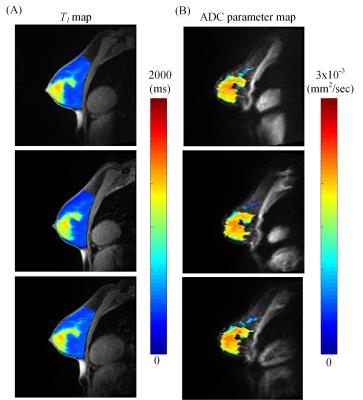 |
Reproducibility of Quantitative DW-MRI and DCE-MRI of the Breast in the Community Setting: Preliminary Results
Anna Sorace, Jack Virostko, Stephanie Barnes, Jeffrey Luci, Debra Patt, Boone Goodgame, Sarah Avery, Thomas Yankeelov
Implementation of quantitative DCE-MRI and DW-MRI in the community setting has the potential to impact patient care for a large number of breast cancer patients. Quantitative DW-MRI and DCE-MRI was assessed in phantoms and normal subjects across three sites. In normal subject fibroglandular tissue, the average percent difference in ADC across sites for all subjects was 1.8%, while the average percent difference in the inversion recovery scan and B1- corrected T1 map were 14% and 7.3%, respectively. Overall, the results from the phantom and normal subject scans reveal that quantitative MRI can be successfully implemented in the community setting.
|
|
2916. 
 |
Ultra-early ADC (apparent diffusion coefficient) footprint successfully detects tumor irradiation and predicts radiotherapy outcome
Faisal Mahmood, Helle Hjorth Johannesen, Poul Geertsen, Rasmus Hvass Hansen
If ultra-early stratification of radiotherapy response was possible it could potentially reduce unnecessary irradiation of normal tissue and improve disease management. In this study repeated diffusion weighted magnetic resonance imaging was conducted along with fractionated radiotherapy in brain metastases patients. It was found that the decrease in the apparent diffusion coefficient (ADC) observed 24 hours after the first radiotherapy fraction may be an indicator of irradiation. Responding patients versus non-responding patients could be differentiated by their corresponding change in ADC seen 48 hours after start of radiotherapy. These findings may have great impact for the emerging hybrid MR – linear-accelerator systems.
|
|
2917. 
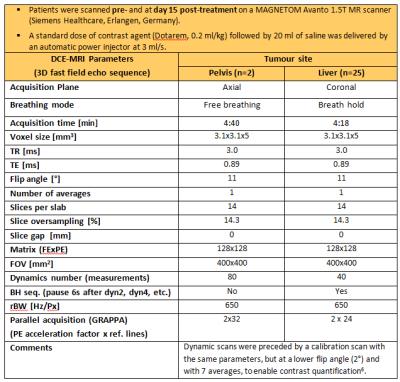 |
Providing improved reliability of plasma volume fraction estimates for monitoring anti-angiogenic effects in liver metastases with DCE-MRI
Mihaela Rata, Khurum Khan, David Collins, Nina Tunariu, Dow-Mu Koh, James d'Arcy, Maria Bali, Ian Chau, Nicola Valeri, David Cunningham, Martin Leach, Matthew Orton
Pharmacokinetic modelling of DCE-MRI data allows characterisation of tumour response to anti-angiogenic therapies by estimating the volume transfer constant Ktrans and the plasma volume fraction Vp. This work assesses the impact on Ktrans and Vp of treatment changes in an early clinical trial cohort by comparing 4 models: Kety, extended Kety (with two lower limits on Vp), and a new model with Vp proportional to Ktrans. When Ktrans is the endpoint of interest, use of the Kety model is sufficient to depict cohort response. If Vp is also of interest, the new model improves the significance of Vp treatment effects.
|
|
2918.
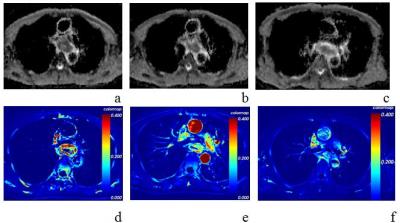 |
Quantitative Evaluation of Treatment Response to Early Concurrent Chemoradiotherapy with Multi-parametric MRI in Esophageal Cancer
Tieming Xie, Guoliang Shao, Lulu Liu, Jun Yang, Peipei Pang
The best dose of concurrent chemoradiotherapy for esophageal cancer exists individual difference because of tumor heterogeneity. The treatment will be more predictable if we can assess the chemoradiotherapy earlier, which will be helpful in early intervention for optimization of treatment plan, treatment time and improvement of overall survival. Multi-parametric MRI is gradually used for evaluating tumor treatment, and provides earlier and more information than conventional MRI. In this study, we used Ktrans value (derived from DCE-MRI) and ADC value (derived from DWI) to assess treatment response after the fifth concurrent chemoradiotherapy in esophageal cancer.
|
|
2919.
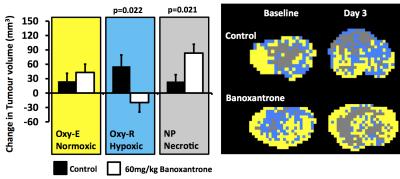 |
In vivo OE-MRI quantification and mapping of response to hypoxia modifying drugs Banoxantrone and Atovaquone in Calu6 xenografts
Ross Little, Victoria Tessyman, Muhammad Babur, Susan Cheung, Yvonne Watson, Roben Gieling, Katherine Finegan, Thomas Ashton, Geoff Parker, W Mckenna, Geoffrey Higgins, Kaye Williams, James O'Connor
Oxygen-enhanced MRI (OE-MRI) has shown promise as a technique for quantifying and spatially mapping tumour hypoxia. Here we report the first evidence that OE-MRI signals in perfused tumour can non-invasively track therapy-induced changes in hypoxia in vivo in a tumour model. We show that OE-MRI detects (1) reduction in hypoxia and increase in necrosis induced by the hypoxia-activated cytotoxic prodrug Banoxantrone; and (2) reduction in hypoxia and increase in well oxygenated tumour induced by Atovaquone due to increased oxygen availability. These data support first-in-man use of OE-MRI biomarkers in clinical trials of hypoxia-modifying agents.
|
|
2920. 
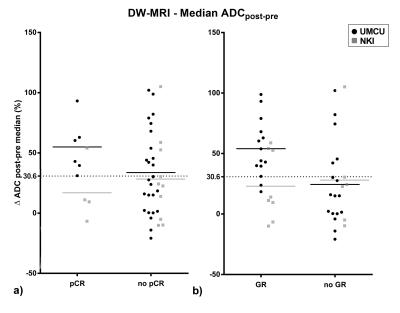 |
Combining DW- and DCE-MRI for treatment response assessment in patients with esophageal cancer undergoing neoadjuvant chemoradiotherapy
Sophie Heethuis, Lucas Goense, Peter van Rossum, Alicia Borggreve, Stella Mook, Francine Voncken, Richard van Hillegersberg, Jelle Ruurda, Gert Meijer, Jan Lagendijk, Astrid van Lier
Neoadjuvant chemoradiotherapy prior to surgery is often used for treatment of patients with esophageal cancer. Potential benefit could be gained developing a patient tailored treatment, especially for the 29% of the patients who show a pathologic complete response. In this prospective multicenter study it was investigated whether combining DCE- and DW-MRI, which both showed potential for response prediction in previous studies, yields complementary information. It was found that the combination of DCE- and DW-MRI can increase the predictive values and reaches higher ROCAUC.
|
|
2921.
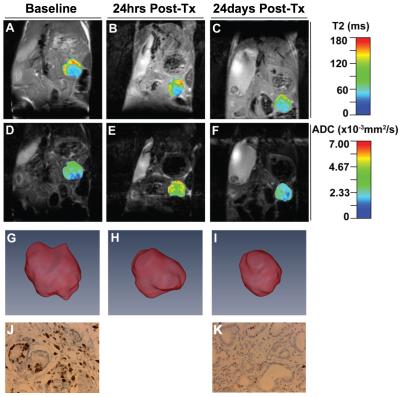 |
MRI biomarkers for PEGPH20-enhanced treatment of pancreatic ductal adenocarcinoma
Ezekiel Maloney, Christopher DuFort, Ravneet Vohra, Markus Carlson, Navid Farr, Paolo Provenzano, Joshua Park, Sunil Hingorani, Donghoon Lee
Pancreatic cancer is a devastating disease with poor prognosis. Pancreatic tumor therapy has been ineffective in part because pancreatic tumors have high interstitial fluid pressure (IFP), driven by high hyaluronan concentration, that inhibits penetration of drugs into the tumor. We performed multi-parametric MRI at high resolution to non-invasively assess tumor response in a KPC mouse model to pegylated recombinant hyaluronidase in isolation as well as combined with Gemcitabine. T1 and T2 relaxation as well as diffusion, and 3 dimensional volume measurements were used to characterize the tumors. MR measurements were compared with invasive IFP measurements and histopathological results.
|
|
2922. 
 |
MRI Efficacy Evaluation of AvastinTM in Combination Temozolomide Therapy using GL261 Tumor Bearing Mice
Min-Kyoung Kang, Sang-Woo Kim, Ig-Jun Cho, Joo-Young Kim, Zhi Fang, Byung-Hwa Hyun, Jae-Jun Lee*
The aim of this study was to evaluate of the drug efficacy used by MRI. A mouse were randomly divided into the control and therapy groups for treatment. MRI were performed to compare with two groups and significant differences were observed in the two groups. The volume transfer constant (Ktrans), flux rate constant (kep) and contrast agent (Gd-DOTA-RGD) enhancement were decreased in the therapy group. Apparent diffusion coefficient (ADC) was lower in the control group. Furthermore, histopathologic assessments were in accord with MRI. Based on these results, efficacy evaluation used by MRI can be helped the development of new bio-drug.
|
|
2923. 
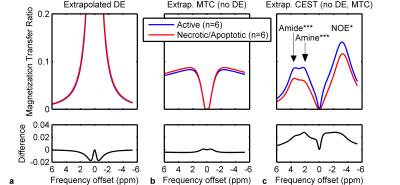 |
Estimation of Contributions to Z-Spectra from CEST and Magnetization Transfer Contrast from Active and Necrotic/Apoptotic Regions of MDA Tumour Xenografts
Wilfred Lam, Jonathan Klein, Farah Hussein, Christine Tarapacki, Gregory Czarnota, Greg Stanisz
Chemical exchange saturation transfer (CEST) MR imaging has been demonstrated to be able to differentiate active from necrotic/apoptotic regions in MDA tumour xenografts. However, the Z-spectrum reflects not only CEST from dissolved proteins, but also contributions from water saturation and magnetization transfer contrast from semisolid macromolecules. We estimated their individual effect sizes and calculated which significantly contribute to the difference in Z-spectrum amplitude between the two tumour regions. The difference in Z-spectrum amplitude between active and necrotic/apoptotic regions in MDA tumour xenografts is due to the CEST effect with minimal contribution from magnetization transfer contrast and direct water saturation.
|
|
2924. 
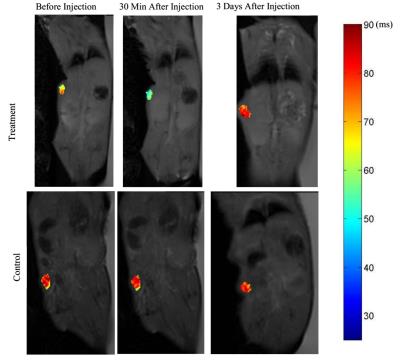 |
In Vivo 3T Clinical Magnetic Resonance Imaging with a Biologically Specific Contrast Agent in Prostate Cancer: A Nude Mouse Model
Christopher Abraham, Prashant Jani, Roxanne Turuba, Michael Campbell, Ingeborg Zehbe, Laura Curiel
In this study we characterized in vivo a functional superparagmagnetic iron-oxide magnetic resonance contrast agent that effects the T2 relaxation time in MRI. The agent was developed by conjugating Molday Ion Carboxyl-6 (MIC6), with a de-immunized mouse monoclonal antibody (muJ591) targeting prostate-specific membrane antigen (PSMA). We propose this functional contrast agent as a non-invasive method to detect prostate cancer cells that are PSMA positive to provide increased differentiability from surrounding tissues for treatment. PSMA-positive prostate tumours were induced into 20 immunocompromised mice. The functional contrast agent was injected into 14 mice leaving 6 mice as controls. MR imaging was performed on a clinical 3T scanner using different parameters on a MESE sequence to obtain T2 relaxation time values. Tumour size, signal intensity, and T2 relaxation time were obtained pre and post injection and were found to have a lower value for treated mice compared to controls. ICP confirmed the increased level of elemental iron in treated mice tumours compared to controls. H&E staining showed healthy morphology of all tissues collected. The reduction in T2 relaxation time for the functional contrast agent, combined with its specificity against PSMA suggest its potential as a biologically-specific MR contrast agent.
|
|
2925.
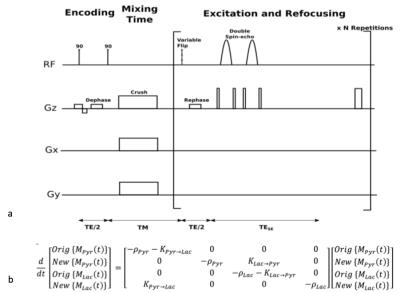 |
Tumor Progression Monitoring with Hyperpolarized 13C Exchange Spectroscopy in Transgenic Adenocarcinoma of Mouse Prostate Treated with Androgen Deprivation Therapy
Zihan Zhu, Robert Bok, Hsin-Yu Chen, John Kurhanewicz, Daniel Vigneron
Hyperpolarized 13C MR imaging provides valuable enzyme-kinetic information for investigating disease metabolism. In this work, a new exchange spectroscopic imaging method was applied to a preclinical cancer treatment study and the metabolic information provided by this new method agreed with and proved additional quantitative kinetic metrics over traditional Response Evaluation Criteria in Solid Tumors (RECIST) measures.
|
|
2926.
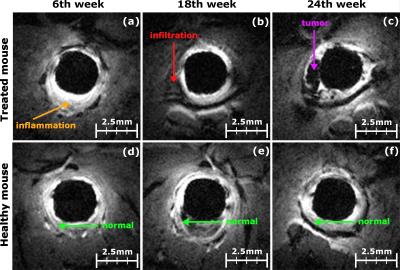 |
In vivo follow-up of colorectal cancer on mice model using endoluminal MRI
Hugo Dorez, Raphaël Sablong, Hélčne Ratiney, Laurence Canaple, Hervé Saint-Jalmes, Sophie Gaillard, Driffa Moussata, Olivier Beuf
For 6 months, 32 mice, chemically treated to induce colorectal cancer, were followed with endoluminal MRI using dedicated endorectal coils. Based on high spatial resolution T1-weigthed images and T1-maps, quantified parameters (colon wall thickness and T1 relaxation time) were measured at each stage of the pathology from healthy tissues to cancer through inflammation. The colon wall thickness was found to be reliable in assessing early stages of the pathology (inflammation from infiltration), where the intrinsic contrast T1 time parameter was reliable for discerning infiltration from tumors. The two biomarkers provide complementary information in the characterization and staging of colorectal cancer.
|
|
2927. 
 |
Combined DCE-MRI and immunohistochemical analyses of cervical cancer xenografts reveal differences in the physiological background of prognostic image parameters derived from the Tofts and Brix model
Tiril Hillestad, Tord Hompland, Anja Nilsen, Trond Stokke, Heidi Lyng
The Tofts and Brix parameters Ktrans and ABrix , derived from dynamic contrast-enhanced MRI (DCE-MRI), have been suggested as potential markers of hypoxia. This phenotype is associated with poor outcome in cervical cancer treated with chemoradiotherapy. In this study, DCE-MRI was combined with immunohistochemical analysis of cervical cancer xenografts, to better understand the physiological background and prognostic potential of the parameters. Through correlations with hypoxic fraction, vascular and cellular densities, derived from pimonidazole, CD31 and hematoxylin staining of tumor sections, respectively, it was shown that ABrix could be the preferred DCE-MRI parameter for predicting hypoxia related treatment resistance in cervical cancer.
|
|
2928.
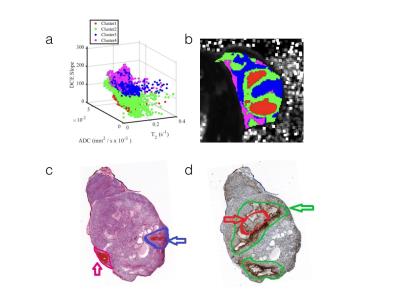 |
Unraveling osteosarcoma tumor heterogeneity using MRI-defined tumor habitats
SUNING HUANG, William Dominguez-Viqueira, Epi Ruiz, Mikalai Budzevich, Bruna Jardim-Perassi, Robert Gillies, Gary Martinez
We explore heterogeneity in osteosarcoma using imaging “habitats”, which identify different physiological subregions by MRI. We propose a method to establish the relationship between the microenvironmental of a habitat by relating histology to MRI. Computational image analysis was used to cluster tumor habitats with a 3D printing approach to co-register MR images with histology and immunohistochemistry. Compared with H&E and the CA-9, we found that cellular morphology and density were in concordance with the clustered habitats, although there are subtle differences between histology and MRI slices. Thus, identifying tumor habitats in osteosarcoma using multiparametric MRI is feasible and promising.
|
|
2929. 
 |
Multi-parametric MRI of glioblastoma invasion quantitative evaluation using histological stacks
Haitham Al-Mubarak, Antoine Vallatos, Lindsay Gallagher, Joanna Birch, Lesley Glmour, John Foster, Anthony Chalmers, William Holmes
We perform a quantitative histological evaluation of a range of MRI techniques in their ability to probe glioblastoma invasion in a mouse model. Using 3-D histological stacks co-registered with MRI slices allows to achieve high values in Dice, sensitivity and specificity tests (>90%). This approach enables to go beyond the standard evaluation tests, performing direct voxel-to-voxel comparison between MRI and histology, and facilitating the development of multi-parametric analysis models. We also identified promising methods for detecting low tumour concentration regions at the invasion limits.
|
|
2930.
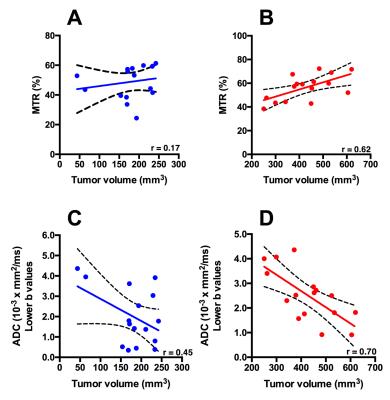 |
Multi-parametric MRI assessment of tumor progression in a mouse model of pancreatic cancer
Ravneet Vohra, Yak-Nam Wang, Joshua Park, Kayla Gravelle, Stella wHang, Joo-Ha Hwang, Donghoon Lee
Pancreatic ductal adenocarcinoma (PDAC) is one of the most common forms of lethal human cancers with poor prognosis. Diagnosis is made usually late in tumor development. There is a dire need to develop sensitive non-invasive biomarkers to diagnose and monitor tumor progression and its associated pathological features. We propose to use multi-parametric MRI (mpMRI) to monitor tumor progression in a genetically engineered KPC mouse model that recapitulates human PDAC. Using mpMRI, we demonstrate that there is a significant correlation between increase in pancreatic tumor volume, Magnetization transfer ratio (MTR), apparent diffusion coefficient (ADC), and chemical exchange saturation transfer (CEST) imaging.
|
|

